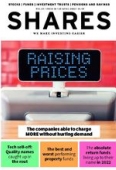Archived article
Please note that tax, investment, pension and ISA rules can change and the information and any views contained in this article may now be inaccurate.
The majority of absolute return funds have lost investors money this year

So far in 2022 investors have had to stomach significant market volatility thanks to worries over rampant inflation, rising interest rates and, more recently, the war in Ukraine.
Given the uncertainties ahead, including the impact of the Ukrainian conflict on the outlook for global growth as the world emerges from Covid, volatility looks certain to continue and so investors may well be looking at investment products which might be useful at protecting against its worst effects.
WHAT ARE ABSOLUTE RETURN FUNDS?
One category of funds that should in theory protect your capital better than traditional funds or investment trusts during market sell-offs are so-called absolute return funds, since they have the ability to ‘short’ the market, namely profit when share prices fall.
There are a few things investors need to consider before investing in these vehicles however. For instance, absolute return funds are not easy to compare; not only do they have different levels of risk but their underlying holdings can vary significantly, with each fund electing to focus on different strategies and asset classes. Some absolute return funds invest in equities, others in bonds or other assets, which makes it difficult to compare performance.
The one characteristic absolute returns funds usually share is a relatively cautious approach and an aim to deliver returns which outpace inflation and protect investors’ money whatever the weather. And yet positive returns aren’t guaranteed and the picture is complicated further by the fact many absolute return funds use different benchmarks to mainstream funds.
With such a variety of strategies and returns, it is vital investors look carefully at what these funds actually invest in and what their aims are before adding one to their portfolio.
GETTING THE JOB DONE
Using FE Fundinfo, Shares has crunched the performance numbers from the retail funds available to UK investors within the Targeted Absolute Return sector in order to see which funds have done their job effectively in a tricky 2022 to date.
Targeted Absolute Return funds are managed with the aim of delivering positive returns in any market conditions, but returns are not guaranteed.
This screen reveals that 26 out of a universe of 59 funds (less than half) have beaten the FTSE All Share index between the start of 2022 and 20 April 2022, though 47 collectives managed to deliver a better total return than that of the MSCI World index.
Please note these are not perfect comparisons because some absolute return funds contain bonds, many investors though will be looking to compare the performance of funds versus UK or global equity indices.
Judging by their remit these funds should be judged on their absolute rather than relative performance and while 22 absolute return funds in our screen have generated positive returns year to date, 35 are actually in negative total return territory.
From these retail vehicles, one of the best performers with a 20.9% haul is VT Argonaut Absolute Return (B7FT1K7) run by Barry Norris. A renowned contrarian with a formidable long-run performance record, Norris manages the fund utilising his ‘earnings surprise’ investment process.
With 52 long holdings and 50 short holdings at the last count, the fund seeks to provide positive absolute returns over a three year rolling period and regardless of market conditions and is not managed against any formal benchmark. According to the March 2022 factsheet commentary, the fund returned 1.43% over March, compared with the IA Targeted Absolute Return sector which returned 0.64 % and ahead of the Lipper Global Alternative Long/Short Equity Europe sector’s 0.85% return.
Other funds that have rewarded investors with positive returns year to date include Orbis Global Cautious Standard (BJ02KT7), which has delivered a 7.7% return through investments in a mix of assets including shares and corporate and government bonds with an exposure to gold. Managed by Orbis Investments, the fund aims to apply a cautious balance between investment returns, and risk of loss using a diversified global portfolio.
ALSO RIDING HIGH
Also riding high is the near-£800 million TM Fulcrum Diversified Absolute Return (BRTNY84), which is up 7.4% year to date. The fund aims to achieve long-term absolute returns of inflation plus 3% to 5% per year in all market conditions over rolling five year annualised periods, with lower volatility than equity markets and in doing so, aims to achieve a positive return on a rolling three year basis.
LF Ruffer Diversified Return (BMWLQW8) is also firmly in positive territory with a 5.5% return year-to-date. This fund seeks to achieve positive returns in all market conditions over any 12 month period, after all costs and charges.
Underlying this objective is the fundamental capital preservation philosophy championed by manager Ruffer, with the canny Duncan MacInnes and Ian Rees steering this portfolio. As of end February 2022, the fund’s was reassuringly diversified across assets ranging from index-linked gilts, cash, gold and short-dated bonds to shares in companies including Shell (SHEL), NatWest (NWG) and GlaxoSmithKline (GSK) as well as Volkswagen (ETR:VOW) and Vodafone (VOD).
And in the face of a trying year to date for fixed income investors, the Arif Husain-managed T. Rowe Price Dynamic Global Bond (BD0NLR3) has eked out a 4.5% total return thanks to a winning mix of government bonds, cash and corporate bonds including high yield.
MUST DO BETTER
Though they can call upon the expertise of vast teams of analysts, among the absolute return vehicles in negative territory year-to-date are funds from the stables of some major asset management giants. They include Invesco Global Targeted Income (BZB27J7), down 8.2% in 2022 so far, as well as JPMorgan Global Macro Opportunities (B4WKYF8), which has shed 7.5%.
And joining them in losses year-to-date is BNY Mellon Sustainable Real Return (BD6DRF7), which is off 7.4% in 2022. Also in the doghouse is ASI Global Absolute Return Strategies (B7K3T22), down 6.8% in the opening four months of the year despite a stated objective to ‘generate a positive absolute return over the medium to long term (three to five years or more) irrespective of market conditions, while reducing the risk of losses’ and running a diversified book of 128 holdings at the last count.
Elsewhere in the losers’ list, Baillie Gifford
Multi Asset Growth B1 (BY9C5Y3) and Baillie Gifford Diversified Growth B2 (BYQCYV6), funds which invest across everything from shares and property to high yield credit, commodities, structured finance, bonds and infrastructure, are down 7% and 6.5% respectively.
Important information:
These articles are provided by Shares magazine which is published by AJ Bell Media, a part of AJ Bell. Shares is not written by AJ Bell.
Shares is provided for your general information and use and is not a personal recommendation to invest. It is not intended to be relied upon by you in making or not making any investment decisions. The investments referred to in these articles will not be suitable for all investors. If in doubt please seek appropriate independent financial advice.
Investors acting on the information in these articles do so at their own risk and AJ Bell Media and its staff do not accept liability for losses suffered by investors as a result of their investment decisions.
Issue contents
Feature
- Great buying opportunities from the big tech rout
- The companies able to charge more without hurting demand
- Explaining the poison pill defence which could have derailed Musk’s Twitter bid
- How big property funds have performed and the different ways to invest
- Emerging markets: Views from the experts
- The best and worst first quarter performers in emerging markets
- Why Unilever has a 10.5% stake in this small cap drug developer
Great Ideas
- Strong reasons to buy Strix, a global leader in niche market
- Loungers maintains fast growth despite facing consumer headwinds
- Brookfield and Homeserve in talks as broker says shares could be worth £15
- Asia Dragon Trust goes shopping for stocks amid market sell-off
- Smartly-timed sale and share buyback reveal Spectris’ hidden value
- Why B&M remains a great way to beat the squeeze
News
- Novacyt faces £134.6 million NHS legal claim
- Can consumer-facing firms beat the big squeeze?
- Growth stocks continue to struggle as we reveal stocks at 52-week highs and lows
- Shares in mining companies hurt by Chinese lockdowns and operational issues
- Why language services group RWS could be the latest private equity victim

 magazine
magazine








